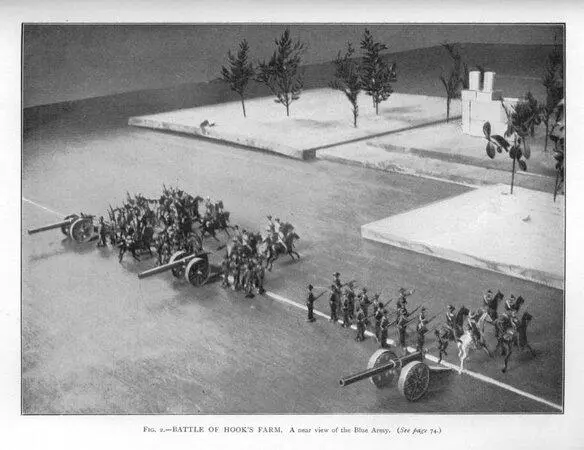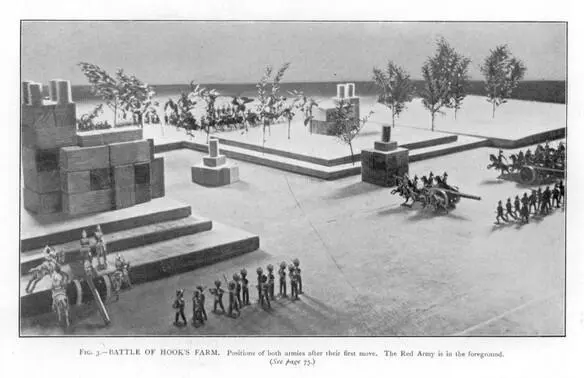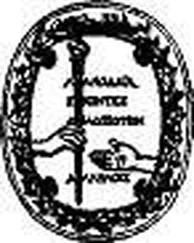Herbert Wells - Little Wars
Здесь есть возможность читать онлайн «Herbert Wells - Little Wars» весь текст электронной книги совершенно бесплатно (целиком полную версию без сокращений). В некоторых случаях можно слушать аудио, скачать через торрент в формате fb2 и присутствует краткое содержание. Год выпуска: 2002, Жанр: Развлечения, на английском языке. Описание произведения, (предисловие) а так же отзывы посетителей доступны на портале библиотеки ЛибКат.
- Название:Little Wars
- Автор:
- Жанр:
- Год:2002
- ISBN:нет данных
- Рейтинг книги:5 / 5. Голосов: 1
-
Избранное:Добавить в избранное
- Отзывы:
-
Ваша оценка:
- 100
- 1
- 2
- 3
- 4
- 5
Little Wars: краткое содержание, описание и аннотация
Предлагаем к чтению аннотацию, описание, краткое содержание или предисловие (зависит от того, что написал сам автор книги «Little Wars»). Если вы не нашли необходимую информацию о книге — напишите в комментариях, мы постараемся отыскать её.
Little Wars — читать онлайн бесплатно полную книгу (весь текст) целиком
Ниже представлен текст книги, разбитый по страницам. Система сохранения места последней прочитанной страницы, позволяет с удобством читать онлайн бесплатно книгу «Little Wars», без необходимости каждый раз заново искать на чём Вы остановились. Поставьте закладку, и сможете в любой момент перейти на страницу, на которой закончили чтение.
Интервал:
Закладка:
(1) The Country must be arranged by one player, who, failing any other agreement, shall be selected by the toss of a coin.
(2) The other player shall then choose which side of the field he will fight from.
(3) The Country must be disturbed as little as possible in each move. Nothing in the Country shall be moved or set aside deliberately to facilitate the firing of guns. A player must not lie across the Country so as to crush or disturb the Country if his opponent objects. Whatever is moved by accident shall be replaced after the end of the move.
(1) After the Country is made and the sides chosen, then (and not until then) the players shall toss for the first move.
(2) If there is no curtain, the player winning the toss, hereafter called the First Player, shall next arrange his men along his back line, as he chooses. Any men he may place behind or in front of his back line shall count in the subsequent move as if they touched the back line at its nearest point. The Second Player shall then do the same. But if a curtain is available both first and second player may put down their men at the same time. Both players may take unlimited time for the putting down of their men; if there is a curtain it is drawn back when they are ready, and the game then begins.


(3) The subsequent moves after the putting down are timed. The length of time given for each move is determined by the size of the forces engaged. About a minute should be allowed for moving 30 men and a minute for each gun. Thus for a force of 110 men and 3 guns, moved by one player, seven minutes is an ample allowance. As the battle progresses and the men are killed off, the allowance is reduced as the players may agree. The player about to move stands at attention a yard behind his back line until the timekeeper says "Go." He then proceeds to make his move until time is up. He must instantly stop at the cry of "Time." Warning should be given by the timekeeper two minutes, one minute, and thirty seconds before time is up. There will be an interval before the next move, during which any disturbance of the Country can be rearranged and men accidentally overturned replaced in a proper attitude. This interval must not exceed five or four minutes, as may be agreed upon.
(4) Guns must not be fired before the second move of the first player—not counting the "putting down" as a move. Thus the first player puts down, then the second player, the first player moves, then the second player, and the two forces are then supposed to come into effective range of each other and the first player may open fire if he wishes to do so.
(5) In making his move a player must move or fire his guns if he wants to do so, before moving his men. To this rule of "Guns First" there is to be no exception.
(6) Every soldier may be moved and every gun moved or fired at each move, subject to the following rules:
(Each player must be provided with two pieces of string, one two feet in length and the other six inches.)
(I) An infantry-man may be moved a foot or any less distance at each move.
(II) A cavalry-man may be moved two feet or any less distance at each move.
(III) A gun is in action if there are at least four men of its own side within six inches of it. If there are not at least four men within that distance, it can neither be moved nor fired.
(IV) If a gun is in action it can either be moved or fired at each move, but not both. If it is fired, it may fire as many as four shots in each move. It may be swung round on its axis (the middle point of its wheel axle) to take aim, provided the Country about it permits; it may be elevated or depressed, and the soldiers about it may, at the discretion of the firer, be made to lie down in their places to facilitate its handling. Moreover, soldiers who have got in front of the fire of their own guns may lie down while the guns fire over them. At the end of the move the gun must be left without altering its elevation and pointing in the direction of the last shot. And after firing, two men must be placed exactly at the end of the trail of the gun, one on either side in a line directly behind the wheels. So much for firing. If the gun is moved and not fired, then at least four men who are with the gun must move up with it to its new position, and be placed within six inches of it in its new position. The gun itself must be placed trail forward and the muzzle pointing back in the direction from which it came, and so it must remain until it is swung round on its axis to fire. Obviously the distance which a gun can move will be determined by the men it is with; if there are at least four cavalry-men with it, they can take the gun two feet, but if there are fewer cavalry-men than four and the rest infantry, or no cavalry and all infantry, the gun will be movable only one foot.
(V) Every man must be placed fairly clear of hills, buildings, trees, guns, etc. He must not be jammed into interstices, and either player may insist upon a clear distance between any man and any gun or other object of at least one-sixteenth of an inch. Nor must men be packed in contact with men. A space of one-sixteenth of an inch should be kept between them.
(VI) When men are knocked over by a shot they are dead, and as many men are dead as a shot knocks over or causes to fall or to lean so that they would fall if unsupported. But if a shot strikes a man but does not knock him over, he is dead, provided the shot has not already killed a man. But a shot cannot kill more than one man without knocking him over, and if it touches several without oversetting them, only the first touched is dead and the others are not incapacitated. A shot that rebounds from or glances off any object and touches a man, kills him; it kills him even if it simply rolls to his feet, subject to what has been said in the previous sentence.
(1) A man or a body of men which has less than half its own number of men on its own side within a move of it, is said to be isolated. But if there is at least half its number of men of its own side within a move of it, it is not isolated; it is supported.
(2) Men may be moved up into virtual contact (one-eighth of an inch or closer) with men of the opposite side. They must then be left until the end of the move.
(3) At the end of the move, if there are men of the side that has just moved in contact with any men of the other side, they constitute a melee. All the men in contact, and any other men within six inches of the men in contact, measuring from any point of their persons, weapons, or horses, are supposed to take part in the melee. At the end of the move the two players examine the melee and dispose of the men concerned according to the following rules:—
Either the numbers taking part in the melee on each side are equal or unequal.
(a) If they are equal, all the men on both sides are killed.
(b) If they are unequal, then the inferior force is either isolated or (measuring from the points of contact) not isolated.
(i) If it is isolated (see (1) above), then as many men become prisoners as the inferior force is less in numbers than the superior force, and the rest kill each a man and are killed. Thus nine against eleven have two taken prisoners, and each side seven men dead. Four of the eleven remain with two prisoners. One may put this in another way by saying that the two forces kill each other off, man for man, until one force is double the other, which is then taken prisoner. Seven men kill seven men, and then four are left with two.
Читать дальшеИнтервал:
Закладка:
Похожие книги на «Little Wars»
Представляем Вашему вниманию похожие книги на «Little Wars» списком для выбора. Мы отобрали схожую по названию и смыслу литературу в надежде предоставить читателям больше вариантов отыскать новые, интересные, ещё непрочитанные произведения.
Обсуждение, отзывы о книге «Little Wars» и просто собственные мнения читателей. Оставьте ваши комментарии, напишите, что Вы думаете о произведении, его смысле или главных героях. Укажите что конкретно понравилось, а что нет, и почему Вы так считаете.



